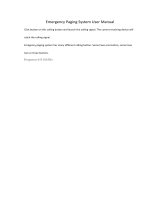
Contents
7
Using Off-hook dialing . . . . . . . . . . . . . . . . . . . . . . . . . . . 64
Using On-hook dialing . . . . . . . . . . . . . . . . . . . . . . . . . . . 65
Using Handsfree dialing . . . . . . . . . . . . . . . . . . . . . . . . . . 66
Using Predial . . . . . . . . . . . . . . . . . . . . . . . . . . . . . . . . . . 68
Activating Ring Again . . . . . . . . . . . . . . . . . . . . . . . . . . . . 69
Using Speed Call . . . . . . . . . . . . . . . . . . . . . . . . . . . . . . . 71
Using System Speed Call . . . . . . . . . . . . . . . . . . . . . . . . 73
Answering a call . . . . . . . . . . . . . . . . . . . . . . . . . . . . . . . . . . . 73
Managing calls during a call . . . . . . . . . . . . . . . . . . . . . . . . . . 74
Using Call Hold . . . . . . . . . . . . . . . . . . . . . . . . . . . . . . . . 74
Using Call Waiting . . . . . . . . . . . . . . . . . . . . . . . . . . . . . . 75
Transferring a call . . . . . . . . . . . . . . . . . . . . . . . . . . . . . . 76
Using Timed Reminder Recall . . . . . . . . . . . . . . . . . . . . . 77
Using Attendant Recall . . . . . . . . . . . . . . . . . . . . . . . . . . . 78
Using Call Park . . . . . . . . . . . . . . . . . . . . . . . . . . . . . . . . 79
Recording a Calling Party (Caller) Number . . . . . . . . . . . 81
Displaying call details . . . . . . . . . . . . . . . . . . . . . . . . . . . . 82
Managing calls while away from your desk . . . . . . . . . . . . . . 82
Using Call Forward . . . . . . . . . . . . . . . . . . . . . . . . . . . . . . 82
Using Internal Call Forward . . . . . . . . . . . . . . . . . . . . . . . 83
Using Remote Call Forward . . . . . . . . . . . . . . . . . . . . . . . 85
Managing multiparty calls . . . . . . . . . . . . . . . . . . . . . . . . . . . . 88
Using Call Join . . . . . . . . . . . . . . . . . . . . . . . . . . . . . . . . . 88
Setting up a Conference Call . . . . . . . . . . . . . . . . . . . . . . 88
Using Conferee Selectable Display . . . . . . . . . . . . . . . . . 89
Using Group Call . . . . . . . . . . . . . . . . . . . . . . . . . . . . . . . 91
Managing calls while busy at work . . . . . . . . . . . . . . . . . . . . . 93
Using Make Set Busy . . . . . . . . . . . . . . . . . . . . . . . . . . . . 93
Hotel applications . . . . . . . . . . . . . . . . . . . . . . . . . . . . . . . . . . 94
Configuring Automatic Wake-Up . . . . . . . . . . . . . . . . . . . 94
Paging features . . . . . . . . . . . . . . . . . . . . . . . . . . . . . . . . . . . 96
Using Call Page Connect to make an announcement . . . 96




















